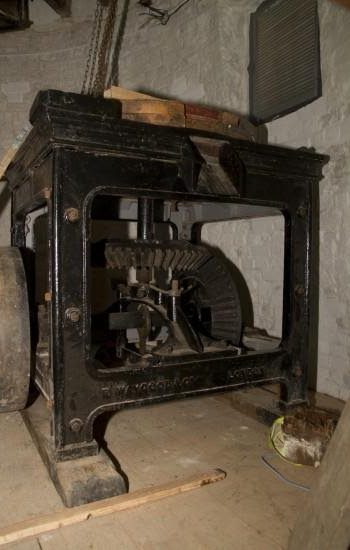In 1902 the lease on the watermill in Mitcham expired. Joshua John Ashby, son of Joshua Ashby, was in charge of the business at this stage and decided to return to the mill in Brixton.
He installed a new iron-clad modular mill that was driven by steam (and later by gas) on the first floor of the mill, so the lack of windpower was no longer a problem. This is the mill that is once again being used to produce flour at Brixton Windmill!
As the demand for finer flour spread across the country, mills were confronted with the choice of trying to survive producing a lower grade product or investing in roller technology. The new millstones were made of French burrstone, a type of quartz that ground much finer flour than the previous Derbyshire gritstone used for milling. The investment paid off, and the business prospered again.
A leaflet published in about 1914 showed the types of products produced and sold by Joshua Ashby & Sons Ltd – their own stoneground flour and wheat meal, which was ground on the premises, and poultry foods specially prepared by the family. They also sold many other products, including white flour, self-raising flour, peas, beans, scotch oatmeal, yeast and rice.
Throughout the 19th century and into the 20th bread was baked in a small bakery situated next to Mill Cottage in the mill yard. In 1959, an elderly Brixton resident claimed that the mill performed an extra trade, when people used to take their gleanings from the wheat fields to be crushed so they would have flour for home baking.
At the centenary of the mill in 1917, according to the press, “the conditions of 100 years ago are maintained in this rural spot and it is a relic of an age which is fast becoming a memory. It is approached by a small roadway hedged with privet, over which nods acacias, limes and filberts, lots of fowl.”
In 1925 it was reported that “London still possesses a windmill though it is not now working. It stands in Cornwall Road, Brixton and has had the sails removed, being transformed into a dwelling house to help in making up the shortage of houses.”
This was actually untrue because the gas engine that worked the modular mill continued in use until 1934, when it was said that demand for wholemeal flour was no longer sufficient to keep the mill running. But it is interesting to note that even in 1925 the mill was seen as a curiosity.
At some point a gallery was constructed around the exterior of the tower’s wooden cap, from which a “wonderful view of London” could be obtained – perhaps another source of income.







